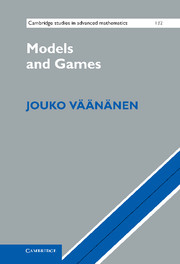3 - Games
Published online by Cambridge University Press: 01 June 2011
Summary
Introduction
In this first part we march through the mathematical details of zero-sum two-person games of perfect information in order to be well prepared for the introduction of the three games of the Strategic Balance of Logic (see Figure 1.1) in the subsequent parts of the book. Games are useful as intuitive guides in proofs and constructions but it is also important to know how to make the intuitive arguments and concepts mathematically exact.
Two-Person Games of Perfect Information
Two-person games of perfect information are like chess: two players set their wits against each other with no role for chance. One wins and the other loses. Everything is out in the open, and the winner wins simply by having a better strategy than the loser.
A Preliminary Example: Nim
In the game of Nim, if it is simplified to the extreme, there are two players I and II and a pile of six identical tokens. During each round of the game player I first removes one or two tokens from the top of the pile and then player II does the same, if any tokens are left. Obviously there can be at most three rounds. The player who removes the last token wins and the other one loses.
The game of Figure 3.1 is an example of a zero-sum two-person game of perfect information. It is zero-sum because the victory of one player is the loss of the other.
- Type
- Chapter
- Information
- Models and Games , pp. 14 - 34Publisher: Cambridge University PressPrint publication year: 2011



